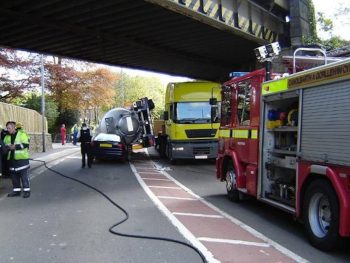E-Training World has launched a new online driver training module focused on reducing the risk of bridge strikes.

Using in-vehicle footage, the new training module helps drivers recognise vital information such as low bridge ahead warning signs. It also trains drivers on what to do in the event of a bridge strike to minimise disruption and damage.
Figures from Network Rail show that whilst there has been some improvement in bridge strike numbers, there is still a long way to go in prevention of incidents.
On average, drivers of at least five heavy goods vehicles and/or buses, put themselves, road users and the public travelling on the trains at risk.
A total of 14 strikes were recorded in one day in 2019, out of a total 1,787 strikes recorded that year, with an estimated cost to the UK economy circa £23m. Some 1,572 bridge strikes were reported across the railway network in the UK from April 2022 to March 2023. Most bridge strikes occur where roads pass under railway bridges. However, all types of bridges can be affected.
Network Rail’s research also found that 32% of drivers admitted to setting off whilst not being aware of the height of their vehicle, with 56% not considering low bridges when planning their journey.
Bridge strikes can cause major traffic delays and cost millions of pounds in repairs. If a railway bridge is struck, the chances of loss of life and injury are even greater because a train could de-rail.
Jonathan Mosley, sales & marketing director at E-Training World, said: “Low bridges are very clearly signposted and marked, and there is really no excuse for a driver to collide with one. However, drivers are either not concentrating, haven’t planned their journey properly, do not know their vehicle height or are willing to take a gamble, and this results in a risk to life, huge disruptions and enormous expense.”
He continued: “The height and width of a vehicle must be displayed inside the cab. But the height and width of a load may change the vehicle’s overall dimensions. If a road has been resurfaced recently, a bridge sign’s height may not be accurate. It is always better to proactively manage the risk by taking a moment to check. By targeting training in risk areas such as bridge strikes, companies can reduce the risk of collisions and build a safe driving culture.”
The new module is the latest development from E-Training World, which is exhibiting at the 2024 Great British Fleet Event.
As well as serving some of the largest fleet operators in the UK, it provides branded/white-labelled systems to many of the best-known companies in the fleet sector. These include insurance companies, fleet management specialists, accident management providers, driver training businesses, vehicle rental specialists and other fleet sector suppliers.

